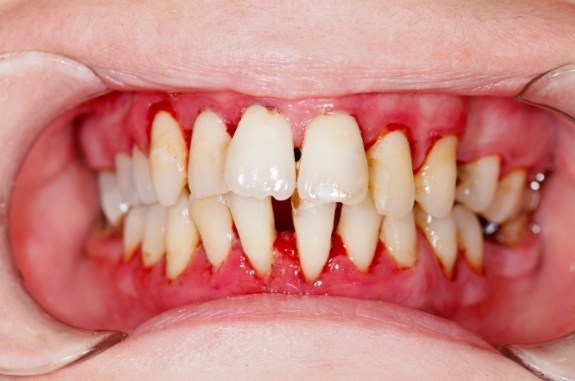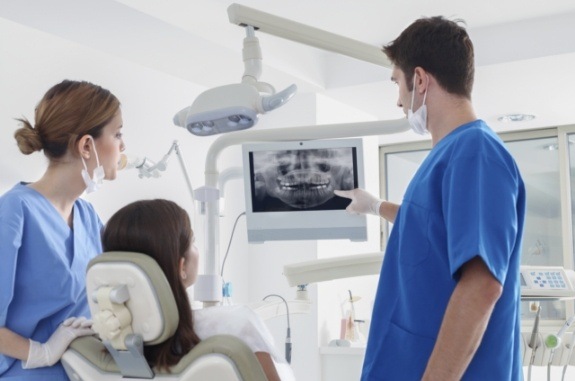Osseous Surgery – Clute, TX
Rebuilding Your Jaw After Gum Disease
Do you have advanced gum disease that has spread into your gums and bone? If so, you can’t treat periodontitis with a regular dental deep cleaning procedure. If you consult a dentist about your periodontitis when it’s still early, you can treat it with a simple scaling and root planing procedure. But if the gum infection spreads to your bones, you have to go for a more invasive periodontal procedure or gum surgery, which is where osseous surgery in Clute comes in. Call us today to learn more and to schedule an appointment.
Why Choose Woodshore Family Dentistry for Osseous Surgery?
- Specialty Dental Procedures Performed In-House
- State-of-the-Art Dental Technology
- Welcoming Service-Oriented Dental Practice
What Is Osseous Surgery?

Osseous surgery is a periodontal procedure in which the dentist either removes some of the infected bone tissues around the tooth or reshapes them. When you suffer from periodontitis, the bacterial infection can spread to your bones. This gum surgery gets rid of that infection, reshapes the bone, and reattaches the gum to the tooth to reverse some of the damage caused by periodontal disease.
The Osseous Gum Surgery Procedure

The osseous gum surgery procedure includes the following steps:
- The dentist numbs the infected region by applying anesthesia, so you don’t feel anything.
- The dentist will make a small incision on the affected gum tissues. After that, they’ll pull back the gum tissue to open up the infected bone.
- Once the dentist has access to the root, they’ll clear it out and remove all the debris and deposits. The dentist will also smooth the bone surface and reshape it.
- The gum tissue will be sutured again so that the wound can heal.
- In some cases, the bacterial infection may have led to severe bone loss. If you don’t have sufficient bone to support the tooth, the dentist will have to conduct a bone grafting procedure to facilitate bone regeneration. During this procedure, the dentist will use grafting material from other parts of your body, other animals, other individuals, or synthetic materials and plant them in the affected region. This will facilitate bone regeneration, and your natural bone will eventually replace the grafted bone. This will restore your bone structure to support the weakened tooth.
When and Why Is Osseous Gum Surgery Necessary?

Brushing and flossing your teeth isn’t enough to remove all of the food particles stuck between your teeth and gums. It’s especially difficult to remove all of the food particles from the deeper recesses of your mouth. These food particles gradually turn into plaque and tartar, and then they attract bacterial infection. When this happens, you suffer from the initial stage of gum disease called gingivitis.
Over time, the bacterial infection spreads below the gumline and also infects your bone, which leads to periodontitis. If you treat gum disease early, you can get rid of the infection with a simple deep cleaning procedure. But if you allow the gum disease to persist, it will infect a considerable portion of your bone structure. In that case, dental deep cleaning is useless and if you don’t do anything, the disease will eventually cause your teeth to fall out or rot away.
That’s when osseous surgery is a last resort to save your infected tooth and reverse some of the damage caused by periodontitis. This procedure will get rid of the infection from your bone and reshape it. It will also perhaps use bone grafts to aid with bone regeneration.
What to Expect After Osseous Gum Surgery

These are some of the things you can expect after the osseous periodontal procedure:
- First, the dentist will place gauze over the incised spot in your gums to stop the bleeding and help the wound heal. You’ll have to change the gauze regularly for as long as the bleeding continues.
- You will have to rinse your mouth regularly with warm salt water. You’ll also be instructed to apply cold compresses on your cheeks — this will help with the swelling.
- After the anesthesia wears off, you’ll experience considerable pain. The doctor will prescribe some over-the-counter medications and painkillers to help manage the pain. You should only take the necessary dosage as prescribed by the doctor.
- You should avoid consuming any hard foods for at least a day or two.
- Once you completely heal after about two days, you’ll be able to resume your regular activities. But you’ll still have to see your dentist after a week so they can check the progress and make sure there are no other complications.
- Following that, you should continue observing oral hygiene habits. Brush your teeth at least twice a day using dentist-recommended toothpaste. Floss your teeth carefully. Rinse your mouth with an antibacterial mouthwash. And also go for all of your scheduled teeth cleaning appointments so that the dentist can routinely remove all accumulated plaque and tartar so you can avoid gum disease in the future.
Gum Disease Treatment Cost

The osseous surgery periodontal treatment cost will depend on the extent of your gum disease and the amount of infected bone. The dentist will also have to observe whether you require bone grafts and to what extent. Based on all of those conditions, periodontal treatment costs can range from just $500 to $10,000. However, the periodontal treatment cost is often covered by insurance, so you don’t have to worry about paying the entire thing on your own.
I Need a Checkup & Cleaning I Need a Dentist for My Child I am Worried About Gum Disease I Have a Cavity or Broken Tooth I am Missing One or More Teeth I Want to Enhance My Smile I Want a Straighter Smile I am Concerned About Sleep Apnea I am Scared of the Dentist I Have Pain in My Jaw I Have a Dental Emergency View Our Services


